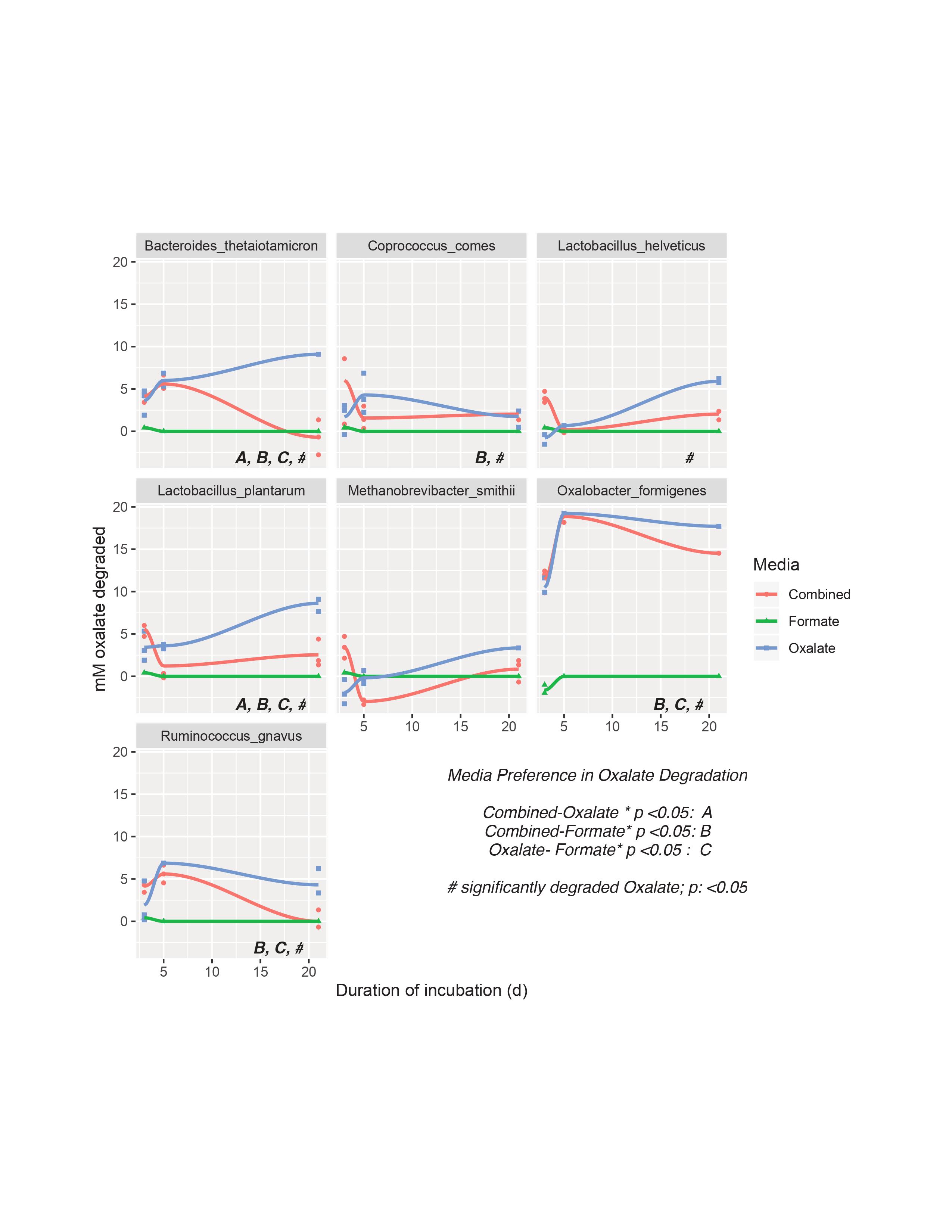Back
Poster, Podium & Video Sessions
Moderated Poster
MP05: Stone Disease: Basic Research & Pathophysiology
MP05-11: Multi-species, metabolic redundancy in oxalate-formate handling in the gut microbiota
Friday, May 13, 2022
8:45 AM – 10:00 AM
Location: Room 225
Sromona Mukherjee*, Aaron Miller, Cleveland, OH

Sromona Mukherjee, PHD,BS,Phd
Cleveland Clinic Foundation
Poster Presenter(s)
Introduction: Calcium oxalate is the predominant mineral in 80% of all cases of urinary stone disease (USD), which has increased in prevalence 4- fold in the last 50 years. Oxalate metabolism occurs exclusively by gut bacteria and modulates enteric hyperoxaluria. Canonically, oxalate degradation in the gut is solely provided by the oxalate-degrading species O. formigenes, which facilitates the inhibition of calcium oxalate stone formation. However meta-analyses suggest that O. formigenes is neither necessary nor sufficient to reduce urinary oxalate excretion nor prevent USD. Recent studies in humans and animals suggest that a diverse network of bacteria, that includes O. formigenes, Methanobrevibacter spp, Desulfovibrio spp, Lactobacillus, Ruminococcus, and others, is responsible for oxalate metabolism rather than a single species. It is unclear whether this network is one in which multiple species degrade oxalate (metabolic redundancy), species interact to successively utilize metabolites produced by oxalate-degradation and downstream processes (metabolic cooperation), or if oxalate-degradation removes this compound as a toxin within the gut environment (synergism). We hypothesize that oxalate-degrading and acetogenic, methanogenic, and sulfate-reducing bacteria exhibit metabolic interactions facilitating oxalate metabolism preventing calcium oxalate stone formation.
Methods: We used 8 different strains of bacteria (figure 1) in a series of in vitro assays to address these questions. Bacteria were grown in anaerobic chamber with 3 different growth medium that contained a complex series of carbon and energy sources and either 1) only oxalate, 2) only formate, or 3) a combination of oxalate and formate. We monitored growth, oxalate degradation, and formate utilization at 3, 5 and 21 days.
Results: It is broadly indicated that multiple bacteria can degrade both oxalate and formate, with both compounds have a significant, differential impact on growth and the utilization of these compounds (Fig 1). Work is on-going to determine if the oxalate degradation is a cooperative function, or solely a redundant phenomenon.
Conclusions: These data will provide insights into the metabolic interactions of various bacteria and how they can help mitigate the impact of oxalate exposure.
Source of Funding: R01 DK121689-01A1 from the NIDDK

Methods: We used 8 different strains of bacteria (figure 1) in a series of in vitro assays to address these questions. Bacteria were grown in anaerobic chamber with 3 different growth medium that contained a complex series of carbon and energy sources and either 1) only oxalate, 2) only formate, or 3) a combination of oxalate and formate. We monitored growth, oxalate degradation, and formate utilization at 3, 5 and 21 days.
Results: It is broadly indicated that multiple bacteria can degrade both oxalate and formate, with both compounds have a significant, differential impact on growth and the utilization of these compounds (Fig 1). Work is on-going to determine if the oxalate degradation is a cooperative function, or solely a redundant phenomenon.
Conclusions: These data will provide insights into the metabolic interactions of various bacteria and how they can help mitigate the impact of oxalate exposure.
Source of Funding: R01 DK121689-01A1 from the NIDDK


.jpg)
.jpg)